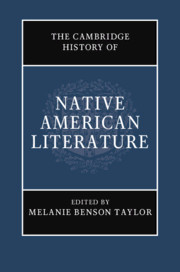Book contents
- The Cambridge History of Native American Literature
- The Cambridge History of Native American Literature
- Copyright page
- Contents
- Figures
- Contributors
- Introduction: What Was Native American Literature?
- Part I Traces and Removals (Pre-1870s)
- Part II Assimilation and Modernity (1879–1967)
- Part III Native American Renaissance (Post-1960s)
- 14 Rethinking the Native American Renaissance: Texts and Contexts
- 15 Marginally Mainstream: Momaday, Silko, Erdrich, and Alexie
- 16 Indigenous Lives, Visual Autobiographies
- 17 Indigenous Writing in Canada
- 18 Reservation Realities and Myths in American Literary History
- 19 Mapping the Future: Indigenous Feminism
- 20 Queer Sovereignty
- 21 Contemporary Indigenous American Poetry
- 22 Contemporary Native North American Drama
- Part IV Visions and Revisions: 21st-Century Prospects
- Index
- References
19 - Mapping the Future: Indigenous Feminism
from Part III - Native American Renaissance (Post-1960s)
Published online by Cambridge University Press: 18 September 2020
- The Cambridge History of Native American Literature
- The Cambridge History of Native American Literature
- Copyright page
- Contents
- Figures
- Contributors
- Introduction: What Was Native American Literature?
- Part I Traces and Removals (Pre-1870s)
- Part II Assimilation and Modernity (1879–1967)
- Part III Native American Renaissance (Post-1960s)
- 14 Rethinking the Native American Renaissance: Texts and Contexts
- 15 Marginally Mainstream: Momaday, Silko, Erdrich, and Alexie
- 16 Indigenous Lives, Visual Autobiographies
- 17 Indigenous Writing in Canada
- 18 Reservation Realities and Myths in American Literary History
- 19 Mapping the Future: Indigenous Feminism
- 20 Queer Sovereignty
- 21 Contemporary Indigenous American Poetry
- 22 Contemporary Native North American Drama
- Part IV Visions and Revisions: 21st-Century Prospects
- Index
- References
Summary
Louise Erdrich’s 2010 novel Shadow Tag, a story about an artist who obsessively paints his Native wife, emphasizes the connections among gender, colonialism, and representation at the heart of indigenous feminism. In the novel, this essay argues, the relationship between Gil and Irene, along with the ways that Gil paints Irene’s body, underscores the centrality of gender in colonialism, the ways that patriarchy has served as both instrument and rationale for colonial processes that carry particular consequences for indigenous women. The novel thus gestures towards the consequent necessity of feminism in anticolonial projects and scrutinizes the role of representation in colonial power and Native resistance. In Erdrich’s story, contests over power and possession unfold in part as contests over representation, and by illustrating the ways that representation is bound up with social power, Shadow Tag ultimately reflects on the political possibilities of Native American literature itself.
Keywords
- Type
- Chapter
- Information
- The Cambridge History of Native American Literature , pp. 365 - 378Publisher: Cambridge University PressPrint publication year: 2020
References
- 8
- Cited by

